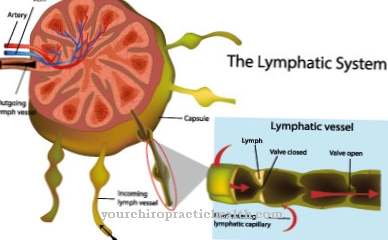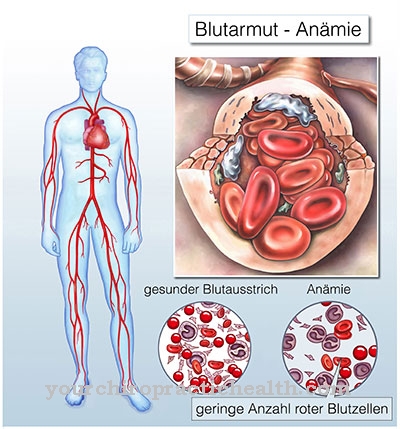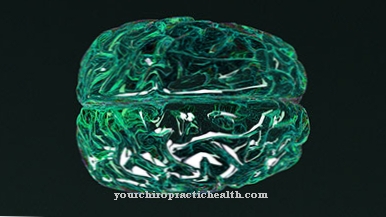The autoimmune disease Myasthenia gravis pseudoparalytica is a muscular weakness which leads to the fatigue of the human muscles. The disease can affect people of all ages and is related to psychological stress. With rapid treatment, the symptoms of myasthenia gravis pseudoparalytica usually resolve quickly.
What is myasthenia gravis pseudoparalytica?

© merla - stock.adobe.com
In the Myasthenia gravis pseudoparalytica it is a very rare form of muscle weakness. This autoimmune disease is characterized by the rapid fatigue of the muscles. The eyes and face are mainly affected by the muscle weakness.
However, as the disease progresses, other muscle groups, including the heart and lungs, may also be affected. Patients with myasthenia gravis pseudoparalytica have symptoms that resemble paralysis.
causes
The causes of a Myasthenia gravis pseudoparalytica are in an impaired neuromuscular transmission, which means that the signals between the muscles and nerves of the affected patient are not transmitted properly.
Myasthenia gravis pseudoparalytica is a disease in which a person's immune system is directed against their own body. Doctors also refer to this as an autoimmune disease. In the case of myasthenia gravis pseudoparalytica, this autoimmune reaction disrupts the neuromuscular transmission, which results in the faster fatigue of the muscles with the symptoms of paralysis.
But even if the thymus - a gland in the human sternum - is changed due to an illness, for example a malignant tumor, this can lead to myasthenia gravis pseudoparalytica. The thymus is responsible for controlling the human immune system, which is why an autoimmune reaction can occur in a diseased gland.
About 80 percent of all patients suffering from myasthenia gravis pseudoparalytica have a disorder of the thymus. But psychological stressful situations such as death or pregnancy can also be the cause of myasthenia gravis pseudoparalytica.
Symptoms, ailments & signs
The first signs of myasthenia gravis pseudoparalytica are usually visual disturbances caused by rapid muscle fatigue. Double vision is typical; the upper eyelids of the eyes often sag on one or both sides and droop (ptosis). In around 20 percent of patients, the disease is limited to these symptoms; the doctor speaks of pure ocular myasthenia gravis.
In many cases, however, the disease spreads to other muscle groups; in principle, all consciously controllable muscles can be affected. A relatively common paralysis of the facial muscles goes hand in hand with the loss of facial expressions: What is striking is the patient's emotionless facial expression. If the disease spreads to the lip, palate, tongue and larynx muscles, speech and swallowing disorders are the result.
Involvement of the respiratory muscles is also possible and manifests itself in increasing shortness of breath: In the worst case, a myasthenic crisis can lead to sudden and massive deterioration with an acute risk of suffocation. Muscles that cannot be controlled voluntarily, such as the heart muscle, are not affected by the disease.
The symptoms of myasthenia gravis pseudoparalytica usually worsen with exertion. The dependence on the time of day is also characteristic: the symptoms are rather weak in the morning and intensify significantly by the evening.
Diagnosis & course
To a Myasthenia gravis pseudoparalytica To diagnose, the affected patient should contact a neurologist. This will first ask the patient in detail about his symptoms and then use certain neurological tests to determine the myasthenia gravis pseudoparalytica.
In addition to the rapid fatigue of the muscles, the typical symptoms are visual disturbances, expressionless facial expressions, swallowing and speech disturbances and heart or lung problems (e.g. shortness of breath). In addition, myasthenia gravis pseudoparalytica can be determined with the help of various drug tests. These are used to check the neuromuscular signal transmission and the resilience of the muscles. Electromyography is also often used if myasthenia gravis pseudoparalytica is suspected.
With the help of this examination, the activity and fatigue of the muscle are analyzed. To identify any changes in the thymus gland, most doctors also recommend a CT scan and chest x-ray.
In the case of myasthenia gravis pseudoparalytica, a reduced life expectancy is not to be expected and the restrictions caused by this disease are also minor in most patients. Regular check-ups with a neurologist should, however, be carried out in order to determine the progression of myasthenia gravis pseudoparalytica in good time.
Complications
Due to myasthenia gravis pseudoparalytica, those affected suffer from considerable restrictions in everyday life. The patient becomes very tired and exhausted, so that physical activities or sports are no longer possible for the person concerned. It is also not uncommon for visual disturbances to occur, which continue to significantly reduce the quality of life of those affected.
Those affected see blurred or double vision, sometimes it comes to so-called veil vision. The muscles seem weak, so development disorders can occur, especially in children. It is not uncommon for this to result in social exclusion or psychological complaints. The muscles in the face are also affected by myasthenia gravis pseudoparalytica, which can lead to swallowing difficulties.
The difficulty in swallowing makes it difficult to take fluids and food, so that patients can suffer from underweight or deficiency symptoms. As a rule, myasthenia gravis pseudoparalytica cannot be treated causally. However, the symptoms can be limited with the help of medication so that the life expectancy of the patient is not reduced. There are no particular complications and the child's development can take place in the usual way.
When should you go to the doctor?
If the person concerned suffers from persistent stress or emotional distress, the help and support of a doctor or therapist should be sought. If there is a decrease in physical performance, a weakening of the muscles or if daily obligations can only be fulfilled to a limited extent, a doctor should be consulted. With rapid fatigue, an increased need for sleep and internal weakness, there is an irregularity that should be investigated. A general feeling of illness, malaise or impaired vision must be discussed with a doctor.
Consult a doctor if double vision, blurred vision or an increased risk of accident and injury occur. There is a need for action in the event of vocal disturbances, irregular swallowing and abnormal heart rhythms. Since a life-threatening condition threatens in severe cases, a doctor should be seen as soon as possible at the first signs. Changes in the muscles in the mouth and throat must be presented to a doctor so that there are no sequelae such as loss of appetite or unwanted weight loss.
A doctor is required in the event of a breathing disorder, difficult breathing or anxiety. If an acute condition arises due to shortness of breath, an ambulance service must be alerted. Until his arrival, first aid measures are to be initiated by those present so that the survival of the person concerned is ensured.
Treatment & Therapy
The neurologist will be with a Myasthenia gravis pseudoparalytica advise treatment with drugs that suppress the body's immune system (immunosuppressants).
In this way, the symptoms of muscle weakness can in most cases be suppressed very well and also over a longer period of time. Furthermore, cholesterase inhibitors have a positive effect on the disturbed neuromuscular transmission. However, they are not suitable for long-term use, as these drugs quickly become less effective.
In very severe cases, for which a pathological change or a tumor of the thymus gland is responsible, or in patients under 50 years of age, the removal of the thymus gland is often recommended. Even if the symptoms of myasthenia gravis pseudoparalytica usually only subside very slowly as a result of the removal, it helps most of the patients permanently.
You can find your medication here
➔ Medicines for muscle weaknessOutlook & forecast
Since the symptoms associated with myasthenia gravis pseudoparalytica can vary greatly in severity and localization, a general prognosis is difficult. However, due to the slow course in most cases, the prognosis is favorable with early and appropriate therapy. The majority of those affected respond well to the treatment measures.
The symptoms decrease so that they can lead a largely normal everyday life with only minor physical restrictions. Myasthenia gravis pseudoparalytica also has no negative impact on life expectancy. However, the attending physician checks the course of the disease at regular intervals in order to identify any deterioration at an early stage and to be able to make any necessary adjustments to the treatment.
Without therapy, however, the symptoms associated with myasthenia gravis pseudoparalytica usually worsen. This leads to serious complications. The respiratory muscles in particular can fail as the disease progresses. Not only is this life threatening and can lead to premature death, but it can also require artificial ventilation for life. For example, earlier, when there was no modern therapy for the disease, around a third of those affected died in the first few years of the disease.
prevention
There are no effective ways to get one Myasthenia gravis pseudoparalytica to prevent. Since psychological stress can be involved in the development of the disease, it is recommended that patients who are already ill are exposed to as little psychological stress as possible. This can at least contain the progression of myasthenia gravis pseudoparalytica.
Aftercare
In most cases of myasthenia gravis pseudoparalytica, those affected have very few and only limited measures and options for direct follow-up care. For this reason, those affected should consult a doctor as early as possible so that there are no further compilations or complaints.The earlier a doctor is contacted, the better the further course of the disease is usually.
Self-healing cannot occur, and the symptoms usually continue to worsen if treatment is not followed. Most of those affected with myasthenia gravis pseudoparalytica are dependent on taking various medications. Care should always be taken to take it regularly and to use the correct dosage in order to alleviate and limit the symptoms.
In the event of side effects or questions, a doctor should always be consulted first. Any changes on the skin should always be checked immediately by a doctor. Complete healing is usually not possible. Often, contact with other sufferers of myasthenia gravis pseudoparalytica also makes sense, as information is exchanged, which can make everyday life easier.
You can do that yourself
Depending on the type of muscle groups affected and the severity of the muscle weakness, there are numerous ways to make everyday life with myasthenia gravis pseudoparalytica easier. The daily routine should be tailored to individual performance - it is especially important to plan enough breaks. In the household, aids such as openers for bottles and disposable glasses or easy-to-use kitchen utensils compensate for lack of muscle strength, a standing aid supports tired legs. Often used items are best kept within easy reach and not above head height, slippers with non-slip soles prevent falls on smooth floors. Power steering and automatic transmissions save valuable energy when driving.
If vision is impaired by double vision, covering one eye with an eye patch or special contact lens can help. So that the eyesight of the covered eye does not continuously decrease, the aid must be used alternately on both eyes. We recommend wearing sunglasses if you have eye problems, especially in bright light.
Nicotine, caffeine and large amounts of alcohol can temporarily worsen the symptoms, and a reaction to strongly smelling substances such as cleaning agents or perfume is possible. Stress and emotional stress, but also changes in weather and infections, often have a strong negative impact on the well-being of those affected. Learning a relaxation technique, but also dealing openly with the disease, is particularly helpful in poorer phases.













.jpg)

.jpg)
.jpg)











.jpg)